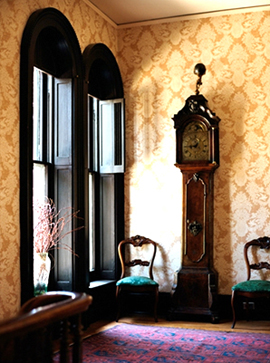
The Vincent House was built in 1872 by one of the first pioneer families in Fort Dodge, James and Adeline Swain. The Swains worked in the wholesale and retail drug business.
During the time that the Swains lived in the house, Adeline dedicated most of her time to educating women. In their home she taught higher education in English, Botany, oil painting, and drawing. Adeline was also the first woman in Iowa to lead the women's rights movement, which furthered the rights of women's suffrage. During the eight years that the Swains lived in the house rooms were rented out to new-comers arriving to Fort Dodge. The house was also rented out for banquets, parties, receptions, and other events.
At one of the parties one such person who attended was the late A.H. Hilton "Gus." He was also accompanied by Mary G. Laufersweiler. Later when the spiritualist movement became popular it caught the attention of the Swains (This movement was believed to communicate with the dead and equality across humanity, especially in gender). The swains formed a small community of followers and held séances in the third floor room which is considered the ballroom.
Adeline was elected state secretary in 1874; her spiritualist followers hosted the state convention. It was during that time that Adeline found her way onto the Greenback political ticket, and was awarded lifetime membership. Governmental meetings were held at her home. After her husband's death in 1877 she moved from Fort Dodge.
In 1879 Webb and Catherine Vincent bought the home, and moved into it in October 17,1879, the house was not yet finished when the Vincents moved into the home. Webb's son Donald was then just a small child. One day, as he was playing on the floor between the dining room and the parlor, he fell into the heating register (as the heating grates had not yet been installed). Donald suffered a broken arm.
Donald met his wife Ann, one summer day when Ann and a friend from Chicago University came back to Fort Dodge and attended a party at the Vincent House. They dated a short time and then were wed. Ann Vincent Roby graduated from University of Chicago in 1901. She was a painter, artist, a wonderful golfer, and a state bridge player at UNI. She was also captain of the woman's basketball team. Ann married her betrothed Donald Vincent, had three children, one of which died at birth. Her daughters were Catherine Deardo and Nancy Vincent Nesbitt. Ann along with Adeline Swain both believed and rallied for equal rights for women.
On April 23rd, 1973, the Vincent House was placed on the National Register of Historic Places (view the official record). The house was officially submitted to the Historic American Buildings Survey, Washington, D.C. in 1972 in a document (HABS No. IA-38) prepared by Iowa State's Wesley I. Shank. For a complete listing of Webster County, Iowa's National Register listings click here.
For travelers coming from out of town, view a 4 page brochure on all the Fort Dodge tourist attractions including the Vincent House, the Oleson Park Band-shell, Blanden Memorial Art Museum and more. It also has information where to stay locally. More information on Fort Dodge tourist attractions available on www.fortdodgecvb.com.